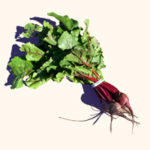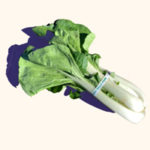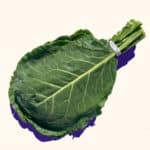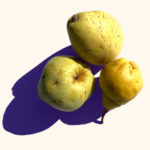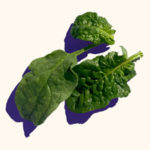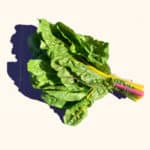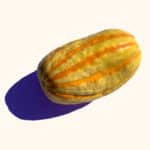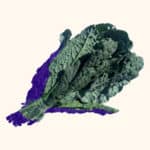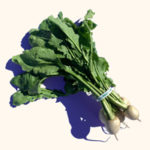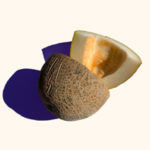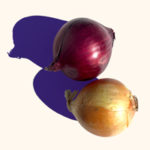What’s in my box this week?
Click on your delivery date to see what is in your box this week. Note that the web site is updated daily to reflect the NEXT day’s deliveries but before that, will show the information from the previous week. You can check an earlier day in the week to get an idea of what will be in your box, but the contents of your box may be different as the box contents frequently change between days.
Tuesday: October 21
- beets
- bok choi
- butternut squash
- cilantro
- collards
- pears
- spinach
*Click on produce above for Recipes
Veggie Tips
Beets – Beets are a two-for-one vegetable. You’re getting the sweet, earthy roots and the greens, which are like a heartier version of chard. Separate the roots from the greens when you get home and store both in bags. Right now the greens are looking amazing so don’t discard them; they’re very similar to chard, just a little heartier. The greens can be sautéed (try Sicilian style with raisins and pine nuts, add roasted beets), added to soup, pickled, made into a pesto, yogurt sauce, or pasta, omelets/frittatas, and more (check out this list). The greens can also be made into chips or fried (tempura). The roots are infinitely adaptable (so many recipe ideas on our website or here) and this list and this list provide rundowns on the various ways to prepare them. Roasting takes the longest but will yield the most flavorful and sweetest results. Beets even make great desserts (brownies, cakes, muffins, and more) and snacks (like chips). You can also cook your beet greens with the roots in a soup (beans or grains) or salad with spinach, bok choi, or quinoa.
Bok Choi – We’re harvesting the large white, stemmed (joi choi) and the shorter green-stemmed (mei qing, or Shanghai). They have different shapes but are equally delicious with crunchy stems and soft leaves. The bigger variety could even be used like lettuce wraps. See this rundown of different cooking methods and the Recipe of the Week for one idea. We love a bok choi stir-fry and CSA members have recommended grilling their choi (“cut in half, grilled with sesame oil and sprinkled with sesame seeds and salt”). No grill? Use a cast iron. It can also be enjoyed raw in a salad (we’ve got several ideas on our website) or pesto (with cilantro!) and is good in soups and with noodles. Other ideas: miso soup, lentil soup, noodles, butternut stew, butternut frittata, sautéed with potatoes. Store in the refrigerator in a bag.
Butternut Squash – Butternut squash is so versatile – see our website and there are even more ideas here, here or here. Butternut soup is great, but there’s lots more you can do. You can eat it with every meal, even breakfast (sweet or savory) and dessert, and it can be even eaten raw, though roasting, the most popular way to make it, will yield the sweetest results. Roasted squash can be added to anything, including a salad or risotto with collards or a roasted beet salad. The seeds can be roasted too, just like pumpkin seeds. Store in a cool, dry place until ready to use. Cut squash can be stored in the fridge, ideally left whole but also in cubes, for several days. More storage tips here.
Cilantro – It’s too hot in summer for us to grow cilantro. We’re excited that it’s cooled down enough to grow this tasty herb! See our herb webpage for some ideas. Don’t let your cilantro bunch go slimy! Cilantro can be added to almost any dish, including the Recipe of the Week, or you can use up a lot at once by making a sauce like mojo verde, pesto, chermoula, dressing, chutney. Or even make a cilantro salad. And don’t discard the stems – they’ve got lots of flavor and have many uses (like this sauce and the ideas on this article). For optimal storage, you have a few options: 1) Roll the cilantro in a paper towel or lightweight cloth towel and store in a bag or container in the refrigerator. Don’t chop or wash your cilantro before storing (washing can be ok if you get it completely dry before storing). 2) Place them upright in a clean glass or jar filled with an inch of water, as you would a bouquet of flowers then loosely cover the leaves with an upside-down plastic bag and put in the fridge. Change the water regularly.
Collards – We love collards, kale’s heartier cousin, and hope you do too. You can use collards anywhere you’d use kale, just perhaps cook or massage a little longer. Collards can be eaten raw (make a salad with roasted squash or peanut sauce or a pesto) or cooked. Some people like making collard wraps (raw or blanched) – the size of these leaves would be great for that. Some cooked collard ideas: a simple sauté, collard oshitashi, Korean style, Ethiopian gomen, a soup with your butternut, braised with coconut milk (add butternut!), and pasta. Don’t discard the stems! They can be used in the same dish, just cooked a little longer, or can be eaten raw, or make a special recipe (pickled or braised). See our website for more ideas – including risotto and a stir-fry with your squash.
Pears – These are Fan-Stil pears! Pears should be stored on the counter at room temperature until they reach your preferred texture, which is a matter of personal preference. Some of us at the farm like them when they have a bit of crunch while others prefer to let them soften up a bit (when there is a slight give when you press on the flesh surrounding the stem – more descriptions of ripe pears here and here). Pears are great just plain, but also make a great addition to salads, desserts (you can add butternut too), oatmeal (raw or cooked – roasted or a compote), smoothies, and more. You can also add your pears to a salad with spinach, beets, collards (cooked or raw), bok choi, or butternut, or make soup! Find more recipe ideas here or here.
Spinach – We grow great spinach, good to enjoy raw, lightly wilted, or cooked (be warned: it shrinks down quite a bit when cooked!). Store in the refrigerator – if not eating within a day or two, transfer to a plastic bag, or put the waxed paper bag in plastic, to avoid wilting. More recipe ideas on our website.
Wednesday: October 22
- beets
- bok choi
- butternut squash
- cilantro
- collards
- pomegranates
- spinach
*Click on produce above for Recipes
Veggie Tips
Beets – Beets are a two-for-one vegetable. You’re getting the sweet, earthy roots and the greens, which are like a heartier version of chard. Separate the roots from the greens when you get home and store both in bags. Right now the greens are looking amazing so don’t discard them; they’re very similar to chard, just a little heartier. The greens can be sautéed (try Sicilian style with raisins and pine nuts, add roasted beets), added to soup, pickled, made into a pesto, yogurt sauce, or pasta, omelets/frittatas, and more (check out this list). The greens can also be made into chips or fried (tempura). The roots are infinitely adaptable (so many recipe ideas on our website or here) and this list and this list provide rundowns on the various ways to prepare them. Roasting takes the longest but will yield the most flavorful and sweetest results. Beets even make great desserts (brownies, cakes, muffins, and more) and snacks (like chips). You can also cook your beet greens with the roots in a soup (beans or grains) or salad with spinach, bok choi, or quinoa.
Bok Choi – We’re harvesting the large white, stemmed (joi choi) and the shorter green-stemmed (mei qing, or Shanghai). They have different shapes but are equally delicious with crunchy stems and soft leaves. The bigger variety could even be used like lettuce wraps. See this rundown of different cooking methods and the Recipe of the Week for one idea. We love a bok choi stir-fry and CSA members have recommended grilling their choi (“cut in half, grilled with sesame oil and sprinkled with sesame seeds and salt”). No grill? Use a cast iron. It can also be enjoyed raw in a salad (we’ve got several ideas on our website) or pesto (with cilantro!) and is good in soups and with noodles. Other ideas: miso soup, lentil soup, noodles, butternut stew, butternut frittata, sautéed with potatoes. Store in the refrigerator in a bag.
Butternut Squash – Butternut squash is so versatile – see our website and there are even more ideas here, here or here. Butternut soup is great, but there’s lots more you can do. You can eat it with every meal, even breakfast (sweet or savory) and dessert, and it can be even eaten raw, though roasting, the most popular way to make it, will yield the sweetest results. Roasted squash can be added to anything, including a salad or risotto with collards or a roasted beet salad. The seeds can be roasted too, just like pumpkin seeds. Store in a cool, dry place until ready to use. Cut squash can be stored in the fridge, ideally left whole but also in cubes, for several days. More storage tips here.
Cilantro – It’s too hot in summer for us to grow cilantro. We’re excited that it’s cooled down enough to grow this tasty herb! See our herb webpage for some ideas. Don’t let your cilantro bunch go slimy! Cilantro can be added to almost any dish, including the Recipe of the Week, or you can use up a lot at once by making a sauce like mojo verde, pesto, chermoula, dressing, chutney. Or even make a cilantro salad. And don’t discard the stems – they’ve got lots of flavor and have many uses (like this sauce and the ideas on this article). For optimal storage, you have a few options: 1) Roll the cilantro in a paper towel or lightweight cloth towel and store in a bag or container in the refrigerator. Don’t chop or wash your cilantro before storing (washing can be ok if you get it completely dry before storing). 2) Place them upright in a clean glass or jar filled with an inch of water, as you would a bouquet of flowers then loosely cover the leaves with an upside-down plastic bag and put in the fridge. Change the water regularly.
Collards – We love collards, kale’s heartier cousin, and hope you do too. You can use collards anywhere you’d use kale, just perhaps cook or massage a little longer. Collards can be eaten raw (make a salad with roasted squash or peanut sauce or a pesto) or cooked. Some people like making collard wraps (raw or blanched) – the size of these leaves would be great for that. Some cooked collard ideas: a simple sauté, collard oshitashi, Korean style, Ethiopian gomen, a soup with your butternut, braised with coconut milk (add butternut!), and pasta. Don’t discard the stems! They can be used in the same dish, just cooked a little longer, or can be eaten raw, or make a special recipe (pickled or braised). See our website for more ideas – including risotto and a stir-fry with your squash.
Pomegranates – Methods abound for how to remove the seeds (submerged underwater, peeling in segments, whacking with a spoon, and more!). Regardless of how you do it, it’s always worth it once you’ve got bowl of beautiful, sweet/tart arils (the seeds) to use in sweet or savory dishes, or eat plain. For best storage, put pomegranates in the refrigerator where they can last up to two months. However, you can leave them out at room temperature where they’ll be fine for a few weeks, though the outside will dry out. Seeds last up to a week in the refrigerator, and you can also juice your pomegranates and freeze the juice. Last year, several CSA members shared that they enjoy them with oatmeal (if you still have quince around, make this!), with yogurt, toast with nut butter, and by the handful! You can add pomegranate seeds to anything! If you want to combine with other produce in your box, make a spinach salad, roasted beets, or add to some roasted butternut or butternut soup. CSA members have shared that they enjoy them with oatmeal, with yogurt, toast with nut butter, and by the handful! A few more recipe ideas and tips on our website.
Spinach – We grow great spinach, good to enjoy raw, lightly wilted, or cooked (be warned: it shrinks down quite a bit when cooked!). Store in the refrigerator – if not eating within a day or two, transfer to a plastic bag, or put the waxed paper bag in plastic, to avoid wilting. More recipe ideas on our website.
Thursday: October 23
- beets
- bok choi
- butternut squash
- cilantro
- collards
- pomegranates
- spinach
*Click on produce above for Recipes
Veggie Tips
Beets – Beets are a two-for-one vegetable. You’re getting the sweet, earthy roots and the greens, which are like a heartier version of chard. Separate the roots from the greens when you get home and store both in bags. Right now the greens are looking amazing so don’t discard them; they’re very similar to chard, just a little heartier. The greens can be sautéed (try Sicilian style with raisins and pine nuts, add roasted beets), added to soup, pickled, made into a pesto, yogurt sauce, or pasta, omelets/frittatas, and more (check out this list). The greens can also be made into chips or fried (tempura). The roots are infinitely adaptable (so many recipe ideas on our website or here) and this list and this list provide rundowns on the various ways to prepare them. Roasting takes the longest but will yield the most flavorful and sweetest results. Beets even make great desserts (brownies, cakes, muffins, and more) and snacks (like chips). You can also cook your beet greens with the roots in a soup (beans or grains) or salad with spinach, bok choi, or quinoa.
Bok Choi – We’re harvesting the large white, stemmed (joi choi) and the shorter green-stemmed (mei qing, or Shanghai). They have different shapes but are equally delicious with crunchy stems and soft leaves. The bigger variety could even be used like lettuce wraps. See this rundown of different cooking methods and the Recipe of the Week for one idea. We love a bok choi stir-fry and CSA members have recommended grilling their choi (“cut in half, grilled with sesame oil and sprinkled with sesame seeds and salt”). No grill? Use a cast iron. It can also be enjoyed raw in a salad (we’ve got several ideas on our website) or pesto (with cilantro!) and is good in soups and with noodles. Other ideas: miso soup, lentil soup, noodles, butternut stew, butternut frittata, sautéed with potatoes. Store in the refrigerator in a bag.
Butternut Squash – Butternut squash is so versatile – see our website and there are even more ideas here, here or here. Butternut soup is great, but there’s lots more you can do. You can eat it with every meal, even breakfast (sweet or savory) and dessert, and it can be even eaten raw, though roasting, the most popular way to make it, will yield the sweetest results. Roasted squash can be added to anything, including a salad or risotto with collards or a roasted beet salad. The seeds can be roasted too, just like pumpkin seeds. Store in a cool, dry place until ready to use. Cut squash can be stored in the fridge, ideally left whole but also in cubes, for several days. More storage tips here.
Cilantro – It’s too hot in summer for us to grow cilantro. We’re excited that it’s cooled down enough to grow this tasty herb! See our herb webpage for some ideas. Don’t let your cilantro bunch go slimy! Cilantro can be added to almost any dish, including the Recipe of the Week, or you can use up a lot at once by making a sauce like mojo verde, pesto, chermoula, dressing, chutney. Or even make a cilantro salad. And don’t discard the stems – they’ve got lots of flavor and have many uses (like this sauce and the ideas on this article). For optimal storage, you have a few options: 1) Roll the cilantro in a paper towel or lightweight cloth towel and store in a bag or container in the refrigerator. Don’t chop or wash your cilantro before storing (washing can be ok if you get it completely dry before storing). 2) Place them upright in a clean glass or jar filled with an inch of water, as you would a bouquet of flowers then loosely cover the leaves with an upside-down plastic bag and put in the fridge. Change the water regularly.
Collards – We love collards, kale’s heartier cousin, and hope you do too. You can use collards anywhere you’d use kale, just perhaps cook or massage a little longer. Collards can be eaten raw (make a salad with roasted squash or peanut sauce or a pesto) or cooked. Some people like making collard wraps (raw or blanched) – the size of these leaves would be great for that. Some cooked collard ideas: a simple sauté, collard oshitashi, Korean style, Ethiopian gomen, a soup with your butternut, braised with coconut milk (add butternut!), and pasta. Don’t discard the stems! They can be used in the same dish, just cooked a little longer, or can be eaten raw, or make a special recipe (pickled or braised). See our website for more ideas – including risotto and a stir-fry with your squash.
Pomegranates – Methods abound for how to remove the seeds (submerged underwater, peeling in segments, whacking with a spoon, and more!). Regardless of how you do it, it’s always worth it once you’ve got bowl of beautiful, sweet/tart arils (the seeds) to use in sweet or savory dishes, or eat plain. For best storage, put pomegranates in the refrigerator where they can last up to two months. However, you can leave them out at room temperature where they’ll be fine for a few weeks, though the outside will dry out. Seeds last up to a week in the refrigerator, and you can also juice your pomegranates and freeze the juice. Last year, several CSA members shared that they enjoy them with oatmeal (if you still have quince around, make this!), with yogurt, toast with nut butter, and by the handful! You can add pomegranate seeds to anything! If you want to combine with other produce in your box, make a spinach salad, roasted beets, or add to some roasted butternut or butternut soup. CSA members have shared that they enjoy them with oatmeal, with yogurt, toast with nut butter, and by the handful! A few more recipe ideas and tips on our website.
Spinach – We grow great spinach, good to enjoy raw, lightly wilted, or cooked (be warned: it shrinks down quite a bit when cooked!). Store in the refrigerator – if not eating within a day or two, transfer to a plastic bag, or put the waxed paper bag in plastic, to avoid wilting. More recipe ideas on our website.
Friday: October 24
- beets
- bok choi
- butternut squash
- cilantro
- collards
- pomegranates
- spinach
*Click on produce above for Recipes
Veggie Tips
Beets – Beets are a two-for-one vegetable. You’re getting the sweet, earthy roots and the greens, which are like a heartier version of chard. Separate the roots from the greens when you get home and store both in bags. Right now the greens are looking amazing so don’t discard them; they’re very similar to chard, just a little heartier. The greens can be sautéed (try Sicilian style with raisins and pine nuts, add roasted beets), added to soup, pickled, made into a pesto, yogurt sauce, or pasta, omelets/frittatas, and more (check out this list). The greens can also be made into chips or fried (tempura). The roots are infinitely adaptable (so many recipe ideas on our website or here) and this list and this list provide rundowns on the various ways to prepare them. Roasting takes the longest but will yield the most flavorful and sweetest results. Beets even make great desserts (brownies, cakes, muffins, and more) and snacks (like chips). You can also cook your beet greens with the roots in a soup (beans or grains) or salad with spinach, bok choi, or quinoa.
Bok Choi – We’re harvesting the large white, stemmed (joi choi) and the shorter green-stemmed (mei qing, or Shanghai). They have different shapes but are equally delicious with crunchy stems and soft leaves. The bigger variety could even be used like lettuce wraps. See this rundown of different cooking methods and the Recipe of the Week for one idea. We love a bok choi stir-fry and CSA members have recommended grilling their choi (“cut in half, grilled with sesame oil and sprinkled with sesame seeds and salt”). No grill? Use a cast iron. It can also be enjoyed raw in a salad (we’ve got several ideas on our website) or pesto (with cilantro!) and is good in soups and with noodles. Other ideas: miso soup, lentil soup, noodles, butternut stew, butternut frittata, sautéed with potatoes. Store in the refrigerator in a bag.
Butternut Squash – Butternut squash is so versatile – see our website and there are even more ideas here, here or here. Butternut soup is great, but there’s lots more you can do. You can eat it with every meal, even breakfast (sweet or savory) and dessert, and it can be even eaten raw, though roasting, the most popular way to make it, will yield the sweetest results. Roasted squash can be added to anything, including a salad or risotto with collards or a roasted beet salad. The seeds can be roasted too, just like pumpkin seeds. Store in a cool, dry place until ready to use. Cut squash can be stored in the fridge, ideally left whole but also in cubes, for several days. More storage tips here.
Cilantro – It’s too hot in summer for us to grow cilantro. We’re excited that it’s cooled down enough to grow this tasty herb! See our herb webpage for some ideas. Don’t let your cilantro bunch go slimy! Cilantro can be added to almost any dish, including the Recipe of the Week, or you can use up a lot at once by making a sauce like mojo verde, pesto, chermoula, dressing, chutney. Or even make a cilantro salad. And don’t discard the stems – they’ve got lots of flavor and have many uses (like this sauce and the ideas on this article). For optimal storage, you have a few options: 1) Roll the cilantro in a paper towel or lightweight cloth towel and store in a bag or container in the refrigerator. Don’t chop or wash your cilantro before storing (washing can be ok if you get it completely dry before storing). 2) Place them upright in a clean glass or jar filled with an inch of water, as you would a bouquet of flowers then loosely cover the leaves with an upside-down plastic bag and put in the fridge. Change the water regularly.
Collards – We love collards, kale’s heartier cousin, and hope you do too. You can use collards anywhere you’d use kale, just perhaps cook or massage a little longer. Collards can be eaten raw (make a salad with roasted squash or peanut sauce or a pesto) or cooked. Some people like making collard wraps (raw or blanched) – the size of these leaves would be great for that. Some cooked collard ideas: a simple sauté, collard oshitashi, Korean style, Ethiopian gomen, a soup with your butternut, braised with coconut milk (add butternut!), and pasta. Don’t discard the stems! They can be used in the same dish, just cooked a little longer, or can be eaten raw, or make a special recipe (pickled or braised). See our website for more ideas – including risotto and a stir-fry with your squash.
Pomegranates – Methods abound for how to remove the seeds (submerged underwater, peeling in segments, whacking with a spoon, and more!). Regardless of how you do it, it’s always worth it once you’ve got bowl of beautiful, sweet/tart arils (the seeds) to use in sweet or savory dishes, or eat plain. For best storage, put pomegranates in the refrigerator where they can last up to two months. However, you can leave them out at room temperature where they’ll be fine for a few weeks, though the outside will dry out. Seeds last up to a week in the refrigerator, and you can also juice your pomegranates and freeze the juice. Last year, several CSA members shared that they enjoy them with oatmeal (if you still have quince around, make this!), with yogurt, toast with nut butter, and by the handful! You can add pomegranate seeds to anything! If you want to combine with other produce in your box, make a spinach salad, roasted beets, or add to some roasted butternut or butternut soup. CSA members have shared that they enjoy them with oatmeal, with yogurt, toast with nut butter, and by the handful! A few more recipe ideas and tips on our website.
Spinach – We grow great spinach, good to enjoy raw, lightly wilted, or cooked (be warned: it shrinks down quite a bit when cooked!). Store in the refrigerator – if not eating within a day or two, transfer to a plastic bag, or put the waxed paper bag in plastic, to avoid wilting. More recipe ideas on our website.
Tuesday: October 14
- chard
- delicata squash
- dino kale
- green beans
- hakurei turnips
- melon
- onions
*Click on produce above for Recipes
Veggie Tips
Chard – Store in the refrigerator in a bag to keep from wilting. Make sure not to discard the stems, as some recipes will tell you to do, they’re the most flavorful part of the plant and have a great texture. You can make something separate with the stems, like pickles, pasta, or braised with beans. Or just chop into small pieces and add a little sooner to your dish when cooking. Chard is related to beets and spinach, which explains the similar taste and appearance. You can use chard in a recipe for spinach (cook more) or other hearty greens like kale (recipe ideas here), just cook less. Most people eat chard lightly cooked (it’s excellent in a simple sauté) or in stews or soups (lots of good ideas on our website) as opposed to raw, but it can be eaten raw in a salad (like this recipe with breadcrumbs, this one with apples, or a Greek salad) or slaw. Or make pesto!
Delicata Squash – Delicata squash are one of our favorites; they have thin skins and don’t need to be peeled. The easiest, and one of the tastiest ways to prepare them is to slice in half, remove the seeds, cut into half-moons, and roast at 400-425 for 25-30 minutes, like this. The slices can be enjoyed plain or added to salads, pasta (or baked pasta), or any other dish. They can also be roasted in halves or sautéed. Halved squash are perfect for stuffing with the filling of your choice (try chard)! They have a shorter shelf-life than many other winter squash, though they don’t need to be eaten ASAP. Even if the squash gets a little soft and wrinkly, they are still fine to eat! You can find some recipe ideas on our website, or here, here, and here.
Dino Kale – Whether you call it dino kale, lacinato, Tuscan, Italian kale, cavolo nero, and or one of its many other names, it’s a great kale variety. It’s excellent raw or cooked. See the Recipe of the Week for a tasty salad from Amon and Jenna’s new cookbook! If not a raw kale fan, you have lots of options. It can be sautéed, braised, stir-fried, added to soups or stews, roasted (chips or a roasted salad), or even grilled. This list has even more cooking methods, and we’ve got many excellent recipes on our website! You’ll often see in recipes to discard the stems. Don’t! The stems are sweet and often are quite tender. You can just add those parts to the pan first, or save them to cook separately (even in a pesto), or even snack on them raw.
Green Beans – Green beans don’t need much to taste great. You can eat them raw, or they are very simple to cook. They can be lightly cooked (quickly blanched, steamed, stir-fried, sautéed, roasted, grilled, or braised) and go well with any sauce or flavor additions (a few ideas here), and with most other produce. Even chard (make a salad or stew), delicata squash (casserole, salad, or curry) or turnips (roasted). We have lots of excellent recipe ideas on our website. Store in the refrigerator in a bag; they will last longer in a plastic bag.
Hakurei Turnips – These farm favorites go by several names: salad turnips, Tokyo turnips, and Japanese turnips. They’re called salad turnips because they have a sweet flavor and taste good raw. They have thin, tender skins; you don’t need to peel. They can also be cooked (roasted, sautéed, boiled, grilled, steamed, mashed). You can use them anywhere you’d use radishes, though they don’t have any of the heat of a radish. They make good pickles, like most root veggies – try with ginger or garlic. Don’t discard the greens; they are tender and soft, with a mild taste. Direct quote from one of our owners, Andrew: “they’re the best part! And really good for you.” You can cook the greens with the turnips (sautéed, pan-roasted, or oven roasted) or use them raw anywhere you’d use arugula or spinach. Pesto too. To store: remove the greens and store the greens and roots in separate plastic bags in the fridge. The greens will last up to a week, but the roots have a much longer shelf-life. Check out the recipes on our website including a delicious miso turnip recipe; a CSA member says that she always makes it when she gets turnips in her box. A few other ideas: a salad with chard, pan-fried with feta and pistachios, or curry noodle soup.
Melon – This week is actually the last week of melons! We hope you’ve enjoyed them. Now is the time to cut and freeze them for use this winter when you’re dreaming of summer. Use the melon page on our website to ID your melon – it’ll likely be a piel de sapo or canary. Melons can be stored on the counter, or in a cool spot, for a short period of time (a day or two) but we harvest them ripe so we recommend keeping them in the refrigerator for best results and bringing them up to room temperature just before eating. Once cut, all melons should be stored in the refrigerator for up to three days either cut up in a container or left whole and wrapped with plastic wrap or an eco-friendly alternative.
Onions
Wednesday: October 15
- chard
- delicata squash
- dino kale
- green beans
- hakurei turnips
- melon
- onions
*Click on produce above for Recipes
Veggie Tips
Chard – Store in the refrigerator in a bag to keep from wilting. Make sure not to discard the stems, as some recipes will tell you to do, they’re the most flavorful part of the plant and have a great texture. You can make something separate with the stems, like pickles, pasta, or braised with beans. Or just chop into small pieces and add a little sooner to your dish when cooking. Chard is related to beets and spinach, which explains the similar taste and appearance. You can use chard in a recipe for spinach (cook more) or other hearty greens like kale (recipe ideas here), just cook less. Most people eat chard lightly cooked (it’s excellent in a simple sauté) or in stews or soups (lots of good ideas on our website) as opposed to raw, but it can be eaten raw in a salad (like this recipe with breadcrumbs, this one with apples, or a Greek salad) or slaw. Or make pesto!
Delicata Squash – Delicata squash are one of our favorites; they have thin skins and don’t need to be peeled. The easiest, and one of the tastiest ways to prepare them is to slice in half, remove the seeds, cut into half-moons, and roast at 400-425 for 25-30 minutes, like this. The slices can be enjoyed plain or added to salads, pasta (or baked pasta), or any other dish. They can also be roasted in halves or sautéed. Halved squash are perfect for stuffing with the filling of your choice (try chard)! They have a shorter shelf-life than many other winter squash, though they don’t need to be eaten ASAP. Even if the squash gets a little soft and wrinkly, they are still fine to eat! You can find some recipe ideas on our website, or here, here, and here.
Dino Kale – Whether you call it dino kale, lacinato, Tuscan, Italian kale, cavolo nero, and or one of its many other names, it’s a great kale variety. It’s excellent raw or cooked. See the Recipe of the Week for a tasty salad from Amon and Jenna’s new cookbook! If not a raw kale fan, you have lots of options. It can be sautéed, braised, stir-fried, added to soups or stews, roasted (chips or a roasted salad), or even grilled. This list has even more cooking methods, and we’ve got many excellent recipes on our website! You’ll often see in recipes to discard the stems. Don’t! The stems are sweet and often are quite tender. You can just add those parts to the pan first, or save them to cook separately (even in a pesto), or even snack on them raw.
Green Beans – Green beans don’t need much to taste great. You can eat them raw, or they are very simple to cook. They can be lightly cooked (quickly blanched, steamed, stir-fried, sautéed, roasted, grilled, or braised) and go well with any sauce or flavor additions (a few ideas here), and with most other produce. Even chard (make a salad or stew), delicata squash (casserole, salad, or curry) or turnips (roasted). We have lots of excellent recipe ideas on our website. Store in the refrigerator in a bag; they will last longer in a plastic bag.
Hakurei Turnips – These farm favorites go by several names: salad turnips, Tokyo turnips, and Japanese turnips. They’re called salad turnips because they have a sweet flavor and taste good raw. They have thin, tender skins; you don’t need to peel. They can also be cooked (roasted, sautéed, boiled, grilled, steamed, mashed). You can use them anywhere you’d use radishes, though they don’t have any of the heat of a radish. They make good pickles, like most root veggies – try with ginger or garlic. Don’t discard the greens; they are tender and soft, with a mild taste. Direct quote from one of our owners, Andrew: “they’re the best part! And really good for you.” You can cook the greens with the turnips (sautéed, pan-roasted, or oven roasted) or use them raw anywhere you’d use arugula or spinach. Pesto too. To store: remove the greens and store the greens and roots in separate plastic bags in the fridge. The greens will last up to a week, but the roots have a much longer shelf-life. Check out the recipes on our website including a delicious miso turnip recipe; a CSA member says that she always makes it when she gets turnips in her box. A few other ideas: a salad with chard, pan-fried with feta and pistachios, or curry noodle soup.
Melon – This week is actually the last week of melons! We hope you’ve enjoyed them. Now is the time to cut and freeze them for use this winter when you’re dreaming of summer. Use the melon page on our website to ID your melon – it’ll likely be a piel de sapo or canary. Melons can be stored on the counter, or in a cool spot, for a short period of time (a day or two) but we harvest them ripe so we recommend keeping them in the refrigerator for best results and bringing them up to room temperature just before eating. Once cut, all melons should be stored in the refrigerator for up to three days either cut up in a container or left whole and wrapped with plastic wrap or an eco-friendly alternative.
Onions
Thursday: October 16
- chard
- delicata squash
- dino kale
- green beans
- hakurei turnips
- melon
- onions
*Click on produce above for Recipes
Veggie Tips
Chard – Store in the refrigerator in a bag to keep from wilting. Make sure not to discard the stems, as some recipes will tell you to do, they’re the most flavorful part of the plant and have a great texture. You can make something separate with the stems, like pickles, pasta, or braised with beans. Or just chop into small pieces and add a little sooner to your dish when cooking. Chard is related to beets and spinach, which explains the similar taste and appearance. You can use chard in a recipe for spinach (cook more) or other hearty greens like kale (recipe ideas here), just cook less. Most people eat chard lightly cooked (it’s excellent in a simple sauté) or in stews or soups (lots of good ideas on our website) as opposed to raw, but it can be eaten raw in a salad (like this recipe with breadcrumbs, this one with apples, or a Greek salad) or slaw. Or make pesto!
Delicata Squash – Delicata squash are one of our favorites; they have thin skins and don’t need to be peeled. The easiest, and one of the tastiest ways to prepare them is to slice in half, remove the seeds, cut into half-moons, and roast at 400-425 for 25-30 minutes, like this. The slices can be enjoyed plain or added to salads, pasta (or baked pasta), or any other dish. They can also be roasted in halves or sautéed. Halved squash are perfect for stuffing with the filling of your choice (try chard)! They have a shorter shelf-life than many other winter squash, though they don’t need to be eaten ASAP. Even if the squash gets a little soft and wrinkly, they are still fine to eat! You can find some recipe ideas on our website, or here, here, and here.
Dino Kale – Whether you call it dino kale, lacinato, Tuscan, Italian kale, cavolo nero, and or one of its many other names, it’s a great kale variety. It’s excellent raw or cooked. See the Recipe of the Week for a tasty salad from Amon and Jenna’s new cookbook! If not a raw kale fan, you have lots of options. It can be sautéed, braised, stir-fried, added to soups or stews, roasted (chips or a roasted salad), or even grilled. This list has even more cooking methods, and we’ve got many excellent recipes on our website! You’ll often see in recipes to discard the stems. Don’t! The stems are sweet and often are quite tender. You can just add those parts to the pan first, or save them to cook separately (even in a pesto), or even snack on them raw.
Green Beans – Green beans don’t need much to taste great. You can eat them raw, or they are very simple to cook. They can be lightly cooked (quickly blanched, steamed, stir-fried, sautéed, roasted, grilled, or braised) and go well with any sauce or flavor additions (a few ideas here), and with most other produce. Even chard (make a salad or stew), delicata squash (casserole, salad, or curry) or turnips (roasted). We have lots of excellent recipe ideas on our website. Store in the refrigerator in a bag; they will last longer in a plastic bag.
Hakurei Turnips – These farm favorites go by several names: salad turnips, Tokyo turnips, and Japanese turnips. They’re called salad turnips because they have a sweet flavor and taste good raw. They have thin, tender skins; you don’t need to peel. They can also be cooked (roasted, sautéed, boiled, grilled, steamed, mashed). You can use them anywhere you’d use radishes, though they don’t have any of the heat of a radish. They make good pickles, like most root veggies – try with ginger or garlic. Don’t discard the greens; they are tender and soft, with a mild taste. Direct quote from one of our owners, Andrew: “they’re the best part! And really good for you.” You can cook the greens with the turnips (sautéed, pan-roasted, or oven roasted) or use them raw anywhere you’d use arugula or spinach. Pesto too. To store: remove the greens and store the greens and roots in separate plastic bags in the fridge. The greens will last up to a week, but the roots have a much longer shelf-life. Check out the recipes on our website including a delicious miso turnip recipe; a CSA member says that she always makes it when she gets turnips in her box. A few other ideas: a salad with chard, pan-fried with feta and pistachios, or curry noodle soup.
Melon – This week is actually the last week of melons! We hope you’ve enjoyed them. Now is the time to cut and freeze them for use this winter when you’re dreaming of summer. Use the melon page on our website to ID your melon – it’ll likely be a piel de sapo or canary. Melons can be stored on the counter, or in a cool spot, for a short period of time (a day or two) but we harvest them ripe so we recommend keeping them in the refrigerator for best results and bringing them up to room temperature just before eating. Once cut, all melons should be stored in the refrigerator for up to three days either cut up in a container or left whole and wrapped with plastic wrap or an eco-friendly alternative.
Onions
Friday: October 17
- chard
- delicata squash
- dino kale
- green beans
- hakurei turnips
- melon
- onions
*Click on produce above for Recipes
Veggie Tips
Chard – Store in the refrigerator in a bag to keep from wilting. Make sure not to discard the stems, as some recipes will tell you to do, they’re the most flavorful part of the plant and have a great texture. You can make something separate with the stems, like pickles, pasta, or braised with beans. Or just chop into small pieces and add a little sooner to your dish when cooking. Chard is related to beets and spinach, which explains the similar taste and appearance. You can use chard in a recipe for spinach (cook more) or other hearty greens like kale (recipe ideas here), just cook less. Most people eat chard lightly cooked (it’s excellent in a simple sauté) or in stews or soups (lots of good ideas on our website) as opposed to raw, but it can be eaten raw in a salad (like this recipe with breadcrumbs, this one with apples, or a Greek salad) or slaw. Or make pesto!
Delicata Squash – Delicata squash are one of our favorites; they have thin skins and don’t need to be peeled. The easiest, and one of the tastiest ways to prepare them is to slice in half, remove the seeds, cut into half-moons, and roast at 400-425 for 25-30 minutes, like this. The slices can be enjoyed plain or added to salads, pasta (or baked pasta), or any other dish. They can also be roasted in halves or sautéed. Halved squash are perfect for stuffing with the filling of your choice (try chard)! They have a shorter shelf-life than many other winter squash, though they don’t need to be eaten ASAP. Even if the squash gets a little soft and wrinkly, they are still fine to eat! You can find some recipe ideas on our website, or here, here, and here.
Dino Kale – Whether you call it dino kale, lacinato, Tuscan, Italian kale, cavolo nero, and or one of its many other names, it’s a great kale variety. It’s excellent raw or cooked. See the Recipe of the Week for a tasty salad from Amon and Jenna’s new cookbook! If not a raw kale fan, you have lots of options. It can be sautéed, braised, stir-fried, added to soups or stews, roasted (chips or a roasted salad), or even grilled. This list has even more cooking methods, and we’ve got many excellent recipes on our website! You’ll often see in recipes to discard the stems. Don’t! The stems are sweet and often are quite tender. You can just add those parts to the pan first, or save them to cook separately (even in a pesto), or even snack on them raw.
Green Beans – Green beans don’t need much to taste great. You can eat them raw, or they are very simple to cook. They can be lightly cooked (quickly blanched, steamed, stir-fried, sautéed, roasted, grilled, or braised) and go well with any sauce or flavor additions (a few ideas here), and with most other produce. Even chard (make a salad or stew), delicata squash (casserole, salad, or curry) or turnips (roasted). We have lots of excellent recipe ideas on our website. Store in the refrigerator in a bag; they will last longer in a plastic bag.
Hakurei Turnips – These farm favorites go by several names: salad turnips, Tokyo turnips, and Japanese turnips. They’re called salad turnips because they have a sweet flavor and taste good raw. They have thin, tender skins; you don’t need to peel. They can also be cooked (roasted, sautéed, boiled, grilled, steamed, mashed). You can use them anywhere you’d use radishes, though they don’t have any of the heat of a radish. They make good pickles, like most root veggies – try with ginger or garlic. Don’t discard the greens; they are tender and soft, with a mild taste. Direct quote from one of our owners, Andrew: “they’re the best part! And really good for you.” You can cook the greens with the turnips (sautéed, pan-roasted, or oven roasted) or use them raw anywhere you’d use arugula or spinach. Pesto too. To store: remove the greens and store the greens and roots in separate plastic bags in the fridge. The greens will last up to a week, but the roots have a much longer shelf-life. Check out the recipes on our website including a delicious miso turnip recipe; a CSA member says that she always makes it when she gets turnips in her box. A few other ideas: a salad with chard, pan-fried with feta and pistachios, or curry noodle soup.
Melon – This week is actually the last week of melons! We hope you’ve enjoyed them. Now is the time to cut and freeze them for use this winter when you’re dreaming of summer. Use the melon page on our website to ID your melon – it’ll likely be a piel de sapo or canary. Melons can be stored on the counter, or in a cool spot, for a short period of time (a day or two) but we harvest them ripe so we recommend keeping them in the refrigerator for best results and bringing them up to room temperature just before eating. Once cut, all melons should be stored in the refrigerator for up to three days either cut up in a container or left whole and wrapped with plastic wrap or an eco-friendly alternative.
Onions
Saturday: October 18
- chard
- delicata squash
- dino kale
- green beans
- hakurei turnips
- melon
- onions
*Click on produce above for Recipes
Veggie Tips
Chard – Store in the refrigerator in a bag to keep from wilting. Make sure not to discard the stems, as some recipes will tell you to do, they’re the most flavorful part of the plant and have a great texture. You can make something separate with the stems, like pickles, pasta, or braised with beans. Or just chop into small pieces and add a little sooner to your dish when cooking. Chard is related to beets and spinach, which explains the similar taste and appearance. You can use chard in a recipe for spinach (cook more) or other hearty greens like kale (recipe ideas here), just cook less. Most people eat chard lightly cooked (it’s excellent in a simple sauté) or in stews or soups (lots of good ideas on our website) as opposed to raw, but it can be eaten raw in a salad (like this recipe with breadcrumbs, this one with apples, or a Greek salad) or slaw. Or make pesto!
Delicata Squash – Delicata squash are one of our favorites; they have thin skins and don’t need to be peeled. The easiest, and one of the tastiest ways to prepare them is to slice in half, remove the seeds, cut into half-moons, and roast at 400-425 for 25-30 minutes, like this. The slices can be enjoyed plain or added to salads, pasta (or baked pasta), or any other dish. They can also be roasted in halves or sautéed. Halved squash are perfect for stuffing with the filling of your choice (try chard)! They have a shorter shelf-life than many other winter squash, though they don’t need to be eaten ASAP. Even if the squash gets a little soft and wrinkly, they are still fine to eat! You can find some recipe ideas on our website, or here, here, and here.
Dino Kale – Whether you call it dino kale, lacinato, Tuscan, Italian kale, cavolo nero, and or one of its many other names, it’s a great kale variety. It’s excellent raw or cooked. See the Recipe of the Week for a tasty salad from Amon and Jenna’s new cookbook! If not a raw kale fan, you have lots of options. It can be sautéed, braised, stir-fried, added to soups or stews, roasted (chips or a roasted salad), or even grilled. This list has even more cooking methods, and we’ve got many excellent recipes on our website! You’ll often see in recipes to discard the stems. Don’t! The stems are sweet and often are quite tender. You can just add those parts to the pan first, or save them to cook separately (even in a pesto), or even snack on them raw.
Green Beans – Green beans don’t need much to taste great. You can eat them raw, or they are very simple to cook. They can be lightly cooked (quickly blanched, steamed, stir-fried, sautéed, roasted, grilled, or braised) and go well with any sauce or flavor additions (a few ideas here), and with most other produce. Even chard (make a salad or stew), delicata squash (casserole, salad, or curry) or turnips (roasted). We have lots of excellent recipe ideas on our website. Store in the refrigerator in a bag; they will last longer in a plastic bag.
Hakurei Turnips – These farm favorites go by several names: salad turnips, Tokyo turnips, and Japanese turnips. They’re called salad turnips because they have a sweet flavor and taste good raw. They have thin, tender skins; you don’t need to peel. They can also be cooked (roasted, sautéed, boiled, grilled, steamed, mashed). You can use them anywhere you’d use radishes, though they don’t have any of the heat of a radish. They make good pickles, like most root veggies – try with ginger or garlic. Don’t discard the greens; they are tender and soft, with a mild taste. Direct quote from one of our owners, Andrew: “they’re the best part! And really good for you.” You can cook the greens with the turnips (sautéed, pan-roasted, or oven roasted) or use them raw anywhere you’d use arugula or spinach. Pesto too. To store: remove the greens and store the greens and roots in separate plastic bags in the fridge. The greens will last up to a week, but the roots have a much longer shelf-life. Check out the recipes on our website including a delicious miso turnip recipe; a CSA member says that she always makes it when she gets turnips in her box. A few other ideas: a salad with chard, pan-fried with feta and pistachios, or curry noodle soup.
Melon – This week is actually the last week of melons! We hope you’ve enjoyed them. Now is the time to cut and freeze them for use this winter when you’re dreaming of summer. Use the melon page on our website to ID your melon – it’ll likely be a piel de sapo or canary. Melons can be stored on the counter, or in a cool spot, for a short period of time (a day or two) but we harvest them ripe so we recommend keeping them in the refrigerator for best results and bringing them up to room temperature just before eating. Once cut, all melons should be stored in the refrigerator for up to three days either cut up in a container or left whole and wrapped with plastic wrap or an eco-friendly alternative.
Onions
